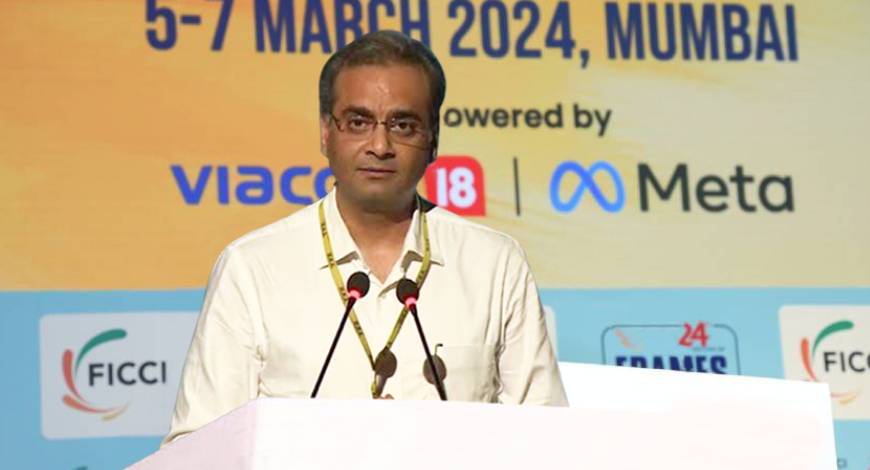Headlines Of The Day
Gaurav Dwivedi at FICCI Frames 2024

Addressing the the 24th edition of FICCI FRAMES 2024, being held at Mumbai March 5-7, 2024 Gaurav Dwivedi, Chief Executive Officer (CEO), Prasar Bharati said, “India is witnessing a massive shift in content consumption and the avenues to consume the content, thanks to the rapid internet growth in the country. This surge in data consumption calls for a better and more organised regulatory framework, given the scope for strong regulatory overlap between telecom and media,.” said Gaurav Dwivedi, Chief Executive Officer (CEO), Prasar Bharati.
In his keynote address on Media, Telecom and Bandwidth: Navigating the Crossroads of Regulation and Consumer Welfare, Dwivedi shared that with the media and entertainment sector expected to reach humongous Rs 2.8 trillion by next year, the regulatory responsibility of those driving the sector becomes paramount. “The key principles of such a regulatory framework should take into account the diverse consumer profile on the one hand and uplifting the regulatory standards on the other,” he added.
The Prasar Bharati CEO highlighted that the digitalization of television and the emergence of new video devices have redefined the broadcast landscape. He said, “The features offered by digital television like personalization of content, interactivity and technical capabilities have brought up a world of new opportunities as well as challenges to all the existing and upcoming stakeholders, which includes content creators, broadcasters, distributors, application developers etc., to reach out and catch the eyeballs of the viewers.
The importance of telecom players in such a dynamic environment cannot be ignored as they are the torchbearers of infrastructure which enables the seamless consumption of this content. This emerging ecosystem is posing a great challenge to the traditional broadcasters, whether terrestrial or satellite. Terrestrial broadcasters need to evolve, innovate, and reach out to the audiences through multiple platforms. They also need to use the new media platforms to complement the services rendered through the traditional broadcasting systems.
This requires a considerable commitment of resources on the emerging platforms and technologies, while sustaining the traditional linear broadcast infrastructure.
OTT services, digital cable and DTH operators are presently competing to occupy more space in the broadcasting industry for the distribution of content. The OTT services have caused disruption to the traditional broadcasting services and are becoming more and more popular, especially in the urban areas. As the services are using internet connections, they can be accessed anywhere.
Many DTH operators are providing access to their services through OTT as well to complement their traditional services and keeping their consumers with them. However, the requirement of reliable high-speed broadband is limiting their reach. This further calls for enhanced harmony between media and telecom.
The market is now segmenting into Pay TV, Free TV and Connected TV, and each platform is sizable. Therefore, content producers, broadcasters and distributors will have to address the needs of each of these groups for better monetization of their services.
Another competing element to the broadcast media ecosystem of late has been the entry of telecom operators. The demands for spectrum by telecom service providers to roll out 4G, LTE, 5G and wireless video streaming services has put a lot of pressure on the broadcasters and a sizable part of the spectrum used by the latter has seen diversion.
This has compelled broadcasters to look for better compression technologies and competing solutions and standards. While allocating spectrum to the telecom operators and other wireless service providers, there’s a need to keep the spectrum reserved for broadcasters to roll out D2M, HDTV and other innovative services.
As TRAI has rightly mentioned in one of its consultation papers, ‘To accommodate new services and the evolving marketplace, many countries are modifying their policy-making and regulatory frameworks and institutions addressing the phenomenon of convergence of the telecom and broadcasting industries’. One of the ways this has been achieved is by merging different regulatory authorities for telecom and broadcasting into a single regulatory body. Large economies around the world like the USA, UK, Australia, EU etc. have established the convergent regulators who are empowered and made responsible for overseeing the complete electronic communication space, which includes telecom, broadcast media and cyberspace.
They have a common body that authorizes or provides licenses to both telecom and broadcast services. Considering the above, but also keeping into account India’s situation and landscape, we are at a stage now where we are ideally suited to discuss, debate, and draw from the best of international practices, keeping in view the specific Indian set of challenges, the consumers profiles, and stakeholders.”
Also read,
Sanjay Jaju at FICCI Frames 2024
Sanjiv Shankar at FICCI Frames 2024
BCS Bureau








